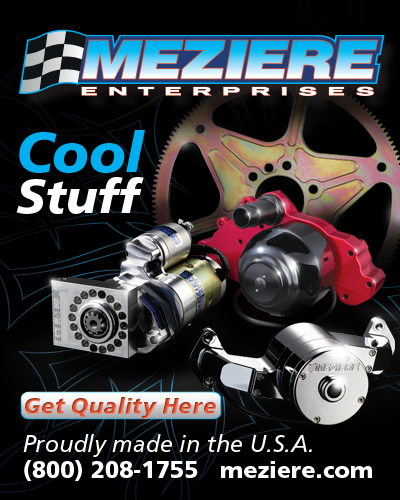ENCORE: BOBBY BENNETT: I AM THE ORIGINAL MELLO YELLO NATS CHAMPION
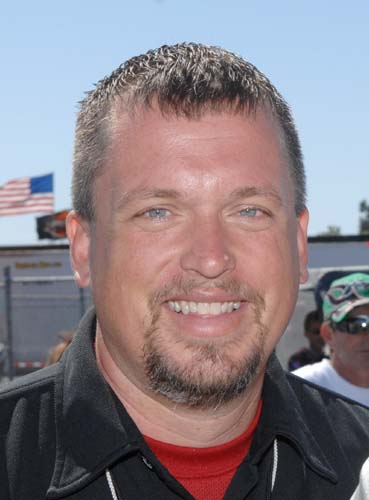
Originally published September 2012
There are times when I miss being a 13-year-old kid with an insatiable drag racing appetite. Sometimes we get lost in our adult perceptions using the past as a barometer for the future.
There are times when youthful enthusiasm is a better approach than age and treachery. Thanks to a ten-year-old girl whom I never met, only read about—my opinion changed.
If you haven’t read Susan Wade’s excellent article about Olivia Byer’s enthusiasm to join her mother, Coca-Cola exec Sharon Byers in the unveiling of the Mello Yello sponsorship for the 2013 NHRA Championship Drag Racing Season, you should.
Before I hit the first keystroke, I was seeking to find a way to criticize yet another brand as series sponsor.
I wasn’t sold on the Mello-Yello series assignment. In fact, I was dead set against it. Many of our readers were too as evidenced by an informal Facebook poll.
Life’s experience has taught me to never look a gift horse in the mouth but for a moment I did. While I appreciated the idea we had a continuing sponsorship, immediately I envisioned a small brand with limited budget and limited activation. In other words, I didn’t feel as if Coca-Cola was going to exercise its full potential at bringing drag racing to mainstream motorsports America. I think, I along with a lot of people, felt Coca-Cola, when they took over the NHRA series sponsorship had the true activation clout capable of filling the void left by R.J. Reynolds’ Winston brand.
Then I did a 180.
Thank you Olivia for helping a seasoned journalist and a 33-year drag racing fan remember an overcast Independence Day in 1980 when my two new loves came together in the ultimate sponsorship activation no one knew about in the real world. In those days, they were my world.
Mello Yello and drag racing consumed my thought processes.
If you will, please travel back in time to 1980 when every other radio station played Billy Joel’s Still Rock & Roll To Me and Paul McCartney’s Coming Up.
We were the Highway 88 Hot Rod Association and between seven of us, we staged the baddest two-wheel drag races our legs could produce.
Unlike today’s generation, we had to play outside for hours and when I became bored with our traditional sandlot baseball games, I encouraged my neighborhood to get involved in the same passion which had overtaken my life 24/7.
I couldn’t get enough of drag racing and at 13, I had a job at the local drag strip and self-published a 12-page black and white magazine sold at the local track for .75 per issue. The circulation was 20 and sold out weekly.
The magazine money covered my NHRA and IHRA memberships and any other racing stuff I came across. The track paid me a whole $5 for a day’s work. The $5 lasted one day and was usually spent at the local Mr. Zip convenience store on any magazine with any reference to drag racing, a Snickers bar and a new soft drink on the market – Mello Yello.
I was always organizing stuff for the neighborhood, whether it was baseball or football games; or in 1980, bicycle drag races. When it was too hot to go outside I was usually socked into the den with nearly 100 or so Hot Wheels cars staging drag races with masking tape stuck to the roof with weird connotations such as C/MP or F/G scribbled with a number. The old-time sportsman racers will recall these were old Modified eliminator classifications.
One day I conjured plans for the ultimate of bicycle drag races. This race would be to Hwy 88-HRA what Indy was to the NHRA.
Using a notebook I used to keep the points for my Hot Wheels Hot Rod Association, I scribbled up the plans for the Mello Yello Nationals presented by Rondo. This would be the ultimate race staged on July 4, and would start at 9 and finish by 3 PM, so I could go to the real drag strip.
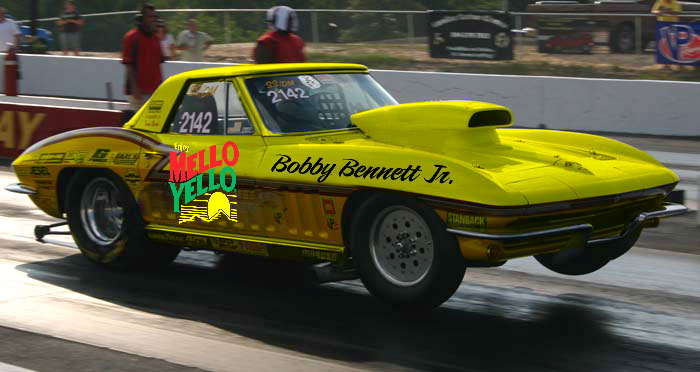 The above photo shows what I envisioned racing. Below show the reality of the bike I raced as a kid.
The above photo shows what I envisioned racing. Below show the reality of the bike I raced as a kid.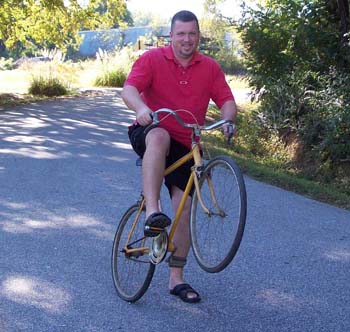 This race would feature every bike in the neighborhood and featured a different prize outside of bragging rights. The winner scored an ice cold six-pack of Mello Yello in the glass bottle, the kind with the eco-unfriendly Styrofoam wrap. The runner-up would get two cans of Rondo. Lose first round and if you got thirsty, you drank water from my grandmother’s water hose in the backyard. Rondo was supposed to be the thirst quencher and there was truth in advertising, after you drank this stuff too quick, you usually got a bellyache and pretty much your thirst was quenched.
This race would feature every bike in the neighborhood and featured a different prize outside of bragging rights. The winner scored an ice cold six-pack of Mello Yello in the glass bottle, the kind with the eco-unfriendly Styrofoam wrap. The runner-up would get two cans of Rondo. Lose first round and if you got thirsty, you drank water from my grandmother’s water hose in the backyard. Rondo was supposed to be the thirst quencher and there was truth in advertising, after you drank this stuff too quick, you usually got a bellyache and pretty much your thirst was quenched.
Basically, the neighborhood youth was at my disposal since I was the oldest. If I said we were playing baseball, then we were playing baseball. Therefore, if I was planning to stage a major drag race, then we did it.
We lived a mile from the real drag strip so everyone was accustomed to hearing the cars and I think a few of us had sneaked in a time or two.
Anyway, I pretty much set the rules and regulations of the Hwy 88-HRA because I was the oldest and somewhat of a bully. Plus, no one knew anything about racing but me so they just kind of went along.
If you wanted to race in our group, I had to first make a drawing of your car you were to emulate, associate it with a Modified eliminator car and assign the bicycle to a bike class. Our classifications weren’t far off of what class racing is based off of. For instance, if you had a three-speed adult bike, you ran in Econo-Pedal. A ten-speed was simply Speed. If you had a reverse braking regular bicycle you ran simply Pedal. One of the newfangled BMX bikes would put you in the Altered category.
Just to give you an idea of how advanced and complex our racing was, as an example, there were three divisions of Econo-Pedal. If you raced A/EP, you did so in first gear. B was second and C was third.
The biggest rule we had required you to scream the sound of the car you were associated with or risk disqualification. Just like the NHRA of today, the race director’s decision was final.
For example, there was no mistaking my A/EP entry was based on a small block 1966 Corvette with a small block, 5-speed transmission with a 50-pound flywheel.
When I rolled to the line, the symphony I screamed out was as beautiful as the Modified cars which raced ever first Saturday of the month at the strip down the road.
I would roll into the foot-etched in the dirt staging beam and bring up the rpms.
“Waaaahhh. Whaaaaaaaah. Whaaaaaaaaaaah. Whaaaapppppppaaaaaaa!” Then the launch and with each scream there was a shift and a small wheelstand.
Did I mention my bike was yellow and sponsored by Mello Yello?
If we won a race, we were given a Peeler’s Milk sticker to go on our bike. The more Peelers decals you had the better you were. The fenders on the bikes were painted the various classifications as well as an index. I usually told everyone what they ran and they just went along with it.
We had our rivalries much like those on the strip and for me, I was rivals with Steven, the red-headed kid across the street who could pedal his new BMX bicycle slicker than oil snot and gave me fits on race day.
Steven (11) was my sworn mortal enemy on the bike drag strip. He was the Dixon to Schumacher, the Pedregon to Force … the Shepherd to Glidden, you get the picture … he had this kind of effect on Me.
If my bike was the equivalent of an E/Modified Production Stingray, Steven’s was a C/Gas Chevrolet Monza.
We had a total of seven bikes for the Mello Yello Nationals. Outside of Steven and I, there was Cousin Phillip (8) on his A/Pedal “Hombre” bike he won in school fundraiser and was the equivalent of a 1971 Camaro G/Modified Production. Then there was Michael (9), Steven’s neighbor, who had a bike just like Phillip’s but orange. He was B/Pedal because he couldn’t ride as well as Phillip, plus his bike was a 1968 Nova and everybody knew at the time Novas couldn’t outrun Camaros.
Jeff and Johnny (12, 10), neighbors to Michael, had some kind of chopper, banana seat bike which would have made Dennis Hopper green with envy. It was painted some kind of purple with flames. We called it C/Pedal because it was unique and associated it with a SS/FA 1971 Mustang because we didn’t like it and a Ford with an automatic successfully epitomized my disdain. They took turns riding.
I also had a second bike, a proverbial first-round duck and a reverse braking bike. The bike was spray painted black with the crude lettering Blackjack 500. This was an F/Modified Production 1967 Camaro and a B/Pedal.
The final bike was Phillip’s little sister Angie, who was 4 at the time. She could barely ride on her training wheel-equipped starter bike. During the course of the race, we’d often have to run out there and help her complete the run. Then when my grandpa ran over her bike, warping the wheel, we resorted to just pushing the bike. We called this bike a D/Pedal, the slowest of the slow, and aligned it with a C/Modified Compact Mercury Bobcat.
Honestly, I couldn’t make up a plan as elaborate as this without it being true.
At the end of the famous, or in the words of the neighborhood kids all grown, infamous Mello Yello Nationals, I rode away with the grand prize of the ice cold Mello Yello drinks. I think I drank three straight before I got a bellyache when I mixed the soda with the wild green apples in the backyard.
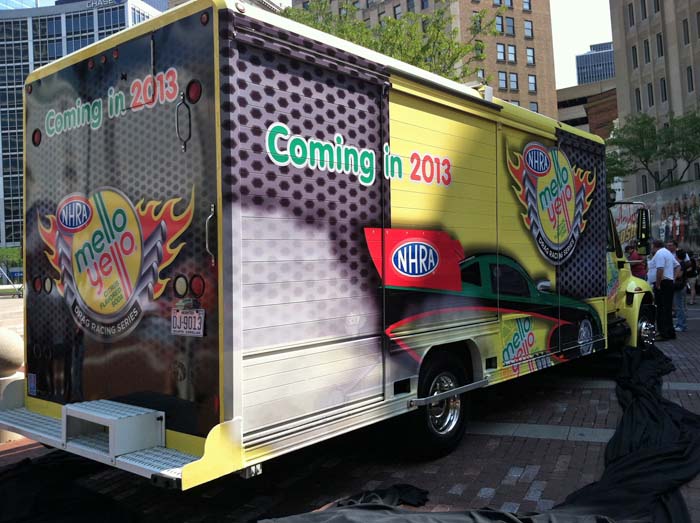 Think Mello Yello is excited about next season?And while there is a blow-by-blow recap of the event below, it was this child-like passion I’d love to see Mello Yello bring to drag racing’s modern activation.
Think Mello Yello is excited about next season?And while there is a blow-by-blow recap of the event below, it was this child-like passion I’d love to see Mello Yello bring to drag racing’s modern activation.
WHAT REALLY HAPPENED AT THE HWY 88 HOT ROD ASSOCIATION NATIONAL EVENT
THE CLASSES - Here’s a breakdown on how the bikes were classified.
Ten Speeds – This category was known simply as SPEED. Speed carried three classifications based on the speed in which a rider competed in: First through third – A/S, Fourth through seventh – B/S, Eight through tenth – C/S.
Three Speeds – This category was known simply as ECONO PEDAL. Econo Pedal carried three classifications based on which gear the rider chose to race in: First gear – A/EP, Second gear – B/EP, Third gear – C/EP.
Regular Pedal Bike with reverse pedal braking – This category was known simply as PEDAL. This class carried three classifications based on (A) the rider’s ability, (B) the quality of their bike and (C) if the bike was so pathetic and the rider equally as bad.
The new BMX bikes – This class was known simply as ALTERED. These things were the devil, so we put them in a class of their own. Certainly none of us wanted to have to run them heads-up, so we got them off on their own. *** Dirt Bike Motorcycles – These were pure exhibition vehicles.The premier event for the Highway 88 Hot Rod Association left no stone unturned when it came to exciting racing and controversy.
Event organizer Bobby Bennett scored the grand prize of the inaugural Hwy 88 Hot Rod Association's Mello Yello Nationals, six glistening glass bottles of Mello Yello while runner-up Cousin Philip scored the runner-up prize of two filled with Rondo drink.
CompetitionPlus.com uncovered the original documents of the greatest drag race the media failed to cover.
The July 4, 1980 event opened under cloudy skies with the threat of rain.
However, this didn't dampen the enthusiasm of the whopping total of seven kids who showed up for the most prestigious event.
The group made time trial runs, screaming their way (and we mean that literally) to strong qualifying time trials. World records were strong as both Bennett (A/Econo Pedal), Steven (A/Altered) and Philip (A/Pedal) established new records. For their efforts, they received prestigious Peeler’s Milk decals on their bikes similar to the old class winner decals.
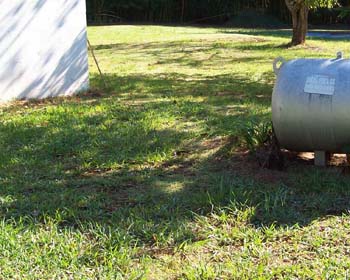
 (SIDEBAR: THE FACILITY - Grandma’s driveway was the only neutral site everyone could bring their bikes and race freely. She lived in one of those cinder block houses, and the drag strip traveled to the curve of the driveway where the dirt transitioned into grass and one rode in a somewhat narrow opening between the house and a large propane tank.
(SIDEBAR: THE FACILITY - Grandma’s driveway was the only neutral site everyone could bring their bikes and race freely. She lived in one of those cinder block houses, and the drag strip traveled to the curve of the driveway where the dirt transitioned into grass and one rode in a somewhat narrow opening between the house and a large propane tank.
There was a turn-off to the left where the return road extended around the house and dumped you off under the huge pecan tree also known as the pits. The opening at the finish line was just wide enough for Grandpa Hoppes to be able to drive his 1966 Biscayne through.
If one couldn’t make the turn they could go long around Grandpa’s shop and turn left but one had better watch out or they could get caught on the clothesline. Yes, that did happen once but we all knew drag racing had its inherent dangers.The pairings would be determined by a drawing of numbers.
Key first-round match ups included a monster out of the gate with Bennett facing Steven; Philip racing archrival Michael, Bobby on Blackjack racing against Angie and Jeff and Johnny receiving the bye run.
Bennett left on Steven in a controversial race where it was argued tree simulator Philip “just didn’t do right and Bobby left early,” but the end result was held up by the race director. Steven eventually went home in protest.
The event was marred by a terrible accident in the second pair as Philip and Michael battled tooth and nail to the grass transition. For some inexplicable reason, Michael nailed the natural gas tank, suffering some minor bruising. Since no bones were sticking out and his glasses weren’t broken, he was deemed okay to continue. Michael did lodge an unsuccessful protest citing that Philip crossed the centerline and forced him over.
A relatively unexciting bye run from Jeff and Johnny closed the round.
The second round opened with a match between Bennett and Jeff with Johnny looking on. Once again, Bennett left on another opponent and pedaled his way to the final round. Again, Philip’s tree simulating practices were questioned, but the ruling stood.
Philip took the bye run into the finals as Jeff and Johnny went home to shoot fireworks.
In the final round, Philip left on Bennett and held the lead for much of the driveway until Bennett screamed by at the transition.
For his victory, Bennett won the six-pack of Mello Yello, with Philip getting the Rondo.
“This was a battle,” said Bennett, who announced he was stepping up to A/Speed in 1981 with a new Takara ten-speed. Sources indicated this ride would be based on an A/Econo Altered 1981 Camaro.
“I am really glad we beat Steven in the first round and I hate it because he had to be such a whiney-butt about it. He can’t take getting beat. I flat outran him. I knew Jeff and Johnny would be tough, but I knew they didn’t have the top end pedal power we did. I was a little afraid of Philip in the final … not really, but we beat him too.”
Bennett had no comment on the controversial tree practices.
WHERE ARE THEY NOW?
Seven riders made up the competition. Their daily jobs today range from being a drag racing journalist to a barber, a nurse, and a rock band member. Two are unaccounted for.
Bennett, the instigator (not organizer) of the whole event, went on to write professionally for leading drag racing magazines.
Philip, Bennett’s cousin now works as a truck driver and races dirt track cars at Cherokee Speedway in his spare time.
Angie, Philip’s little sister and now an LPN Nurse, works at a doctor’s office in kidney dialysis.
Michael, the neighbor across the street from Grandma’s house, is in a rock band.
Steven, who followed in his father’s steps as a barber, took over his dad’s business several years ago. He now cuts Bobby's hair <gasp>
Jeff and Johnny, lived alongside Michael, moved away from the neighborhood several years after the event and are now said to be successful businessmen.
























